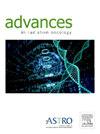锥形束计算机断层扫描引导下在线适应放射治疗全乳的临床应用
IF 2.2
Q3 ONCOLOGY
引用次数: 0
摘要
目的在术后乳房照射中,乳房轮廓和手臂位置的改变可能导致患者定位错误和离线重新规划。由于需要额外的锥形束计算机断层扫描(CBCT)图像,甚至需要新的放射治疗计划(TP),这可能导致治疗负担的增加和部门后勤的紧张。在线每日适应性放射治疗(oART)可以为这些挑战提供解决方案。我们已经临床实施并评估了oART全乳照射的可行性。方法和材料20例术后全乳右侧放射治疗(5 × 5.2 Gy)的患者纳入breast - art,一项前瞻性单臂试验。比较了每日解剖计算的参考总磷和自适应总磷的剂量学。收集了oART工作流程的持续时间、内部满意度问卷和急性毒性(美国国家癌症研究所不良事件通用术语标准v5.0)。通过调查人工校正影响者和目标轮廓对治疗时间和质量的影响,评估了oART工作流程。结果在前17例患者(85组)中,卧床时间,即CBCT1和CBCT3结束之间的时间,中位数为13.8分钟(范围11-25分钟)。回顾性评估了4例患者(20个部分)使用影响器(即乳房)和10例患者(36个部分)手动矫正大部分颅部和尾端目标轮廓(即4mm)。这导致最后3名临床患者的卧床时间减少到13.0分钟(范围11-19)。没有观察到3级或更高的毒性,20名患者中有19名表示他们更愿意再次接受相同的治疗。治疗过程中患者体位的皮肤标记不再需要。结论本研究显示了在乳腺癌患者中实施oART的可行性、挑战和切实可行的解决方案。未来的工作将集中在更复杂的乳房适应症上,如全乳,包括腋窝淋巴结,以进一步研究oART治疗乳腺癌的益处和挑战。本文章由计算机程序翻译,如有差异,请以英文原文为准。
Clinical Implementation of Cone Beam Computed Tomography-Guided Online Adaptive Radiation Therapy in Whole Breast Irradiation
Purpose
In postoperative breast irradiation, changes in the breast contour and arm positioning can result in patient positioning errors and offline replanning. This can lead to increased treatment burden and strain on departmental logistics because of the need for additional cone beam computed tomography (CBCT) images or even a new radiation therapy treatment plan (TP). Online daily adaptive radiation therapy (oART) could provide a solution to these challenges. We have clinically implemented and evaluated the feasibility of oART for whole breast irradiation.
Methods and Materials
Twenty patients treated with postoperative whole breast right irradiation (5 × 5.2 Gy) were included in BREAST-ART, a prospective single-arm trial. The dosimetry of the reference TP calculated on the daily anatomy and adaptive TP were compared. Duration of the oART workflow, in-house satisfaction questionnaires, and acute toxicity (National Cancer Institute Common Terminology Criteria for Adverse Event v5.0) were collected. The oART workflow was evaluated by investigating the impact of manual corrections of influencer and target contours on treatment time and quality.
Results
In the first 17 patients (85 fractions), the on-couch time, ie, the time between the end of CBCT1 and CBCT3, was a median of 13.8 minutes (range, 11–25). Retrospective evaluation of the use of the influencer (ie, breast) in 4 patients (20 fractions) and manual correction of the most cranial and caudal target contours (ie, 4 mm) in 10 patients (36 fractions) was done. This resulted in a reduced on-couch time in the last 3 clinical patients to a median of 13.0 minutes (range, 11–19). No grade 3 or higher toxicity was observed, and 19 of 20 patients indicated that they preferred the same treatment again. Skin marks for patient positioning during treatment were no longer necessary.
Conclusions
This study showed the feasibility, challenges, and practical solutions for the implementation of oART for breast cancer patients. Future work will focus on more complex breast indications, such as whole breast, including axillary nodes, to further investigate the benefits and challenges of oART in breast cancer.
求助全文
通过发布文献求助,成功后即可免费获取论文全文。
去求助
来源期刊

Advances in Radiation Oncology
Medicine-Radiology, Nuclear Medicine and Imaging
CiteScore
4.60
自引率
4.30%
发文量
208
审稿时长
98 days
期刊介绍:
The purpose of Advances is to provide information for clinicians who use radiation therapy by publishing: Clinical trial reports and reanalyses. Basic science original reports. Manuscripts examining health services research, comparative and cost effectiveness research, and systematic reviews. Case reports documenting unusual problems and solutions. High quality multi and single institutional series, as well as other novel retrospective hypothesis generating series. Timely critical reviews on important topics in radiation oncology, such as side effects. Articles reporting the natural history of disease and patterns of failure, particularly as they relate to treatment volume delineation. Articles on safety and quality in radiation therapy. Essays on clinical experience. Articles on practice transformation in radiation oncology, in particular: Aspects of health policy that may impact the future practice of radiation oncology. How information technology, such as data analytics and systems innovations, will change radiation oncology practice. Articles on imaging as they relate to radiation therapy treatment.
 求助内容:
求助内容: 应助结果提醒方式:
应助结果提醒方式:


